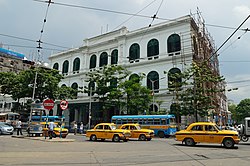 Currency Building, viewed from B. B. D. Bagh (formerly the 'Dalhousie Square') | |
 | |
Former name | Agra Bank Agra and Masterman's Bank Currency Office Reserve Bank of India Old Currency Building[1] |
|---|---|
| Established | 1833 (built) 1868 (Currency Office conversion) 2020 (post-renovation dedication) |
| Location | Old Court House Road and Surendra Mohan Ghosh Sarani, Lal Dighi, B. B. D. Bagh (Dalhousie Square), Kolkata, West Bengal, India |
| Coordinates | 22°34′14″N 88°21′01″E / 22.57056°N 88.35028°E |
| Type | Museum |
| Curator | DAG Museums National Gallery of Modern Art (NGMA) |
| Public transit access | |
The Currency Building is an early 19th-century building in the B. B. D. Bagh (Dalhousie Square) central business district of Kolkata in West Bengal, India. The building was originally built in 1833 to house the Calcutta branch of the Agra Bank. In 1868, it was converted for use by the Office of the Issue and Exchange of Government Currency, an office of the Controller of the Currency under the British Raj. From 1935 until 1937, the Reserve Bank of India (RBI) used the building as its first central office. The building remained in use, and was used at one time by the Central Public Works Department (CPWD) as a storehouse. Authorities decided to demolish it in 1994.
From 1996 to 1998, the CPWD undertook demolition; but the building was saved from being completely demolished by the Indian National Trust for Art and Cultural Heritage (INTACH) and the Kolkata Municipal Corporation. In 2003, custodianship passed to the Archaeological Survey of India (ASI), which renovated the building from 2005 to 2019. On 11 January 2020, Prime Minister Narendra Modi formally dedicated and reopened it as a museum.
The Currency Building is a three-story Italianate structure, consisting of floors covered by marble and Chunar sandstone. Its main entrance features a three-part gate made of wrought iron and Venetian windows. The building's central hall, now an open-air courtyard, was formerly topped by three large domes with skylights. During its use as a currency office, the central hall contained the exchange counters for banknotes, gold, silver, and small change. During the building's renovation, the central hall was reorganized into a space for open-air programmes.
- ^ Madhukalya, Amrita (11 January 2020). "PM Modi to begin two-day visit to Kolkata, inaugurate 4 revamped buildings". Hindustan Times. New Delhi. Archived from the original on 16 January 2020. Retrieved 19 December 2020.